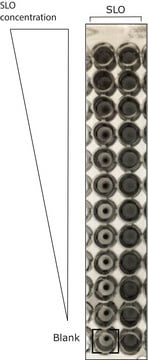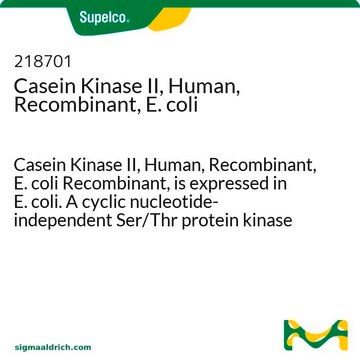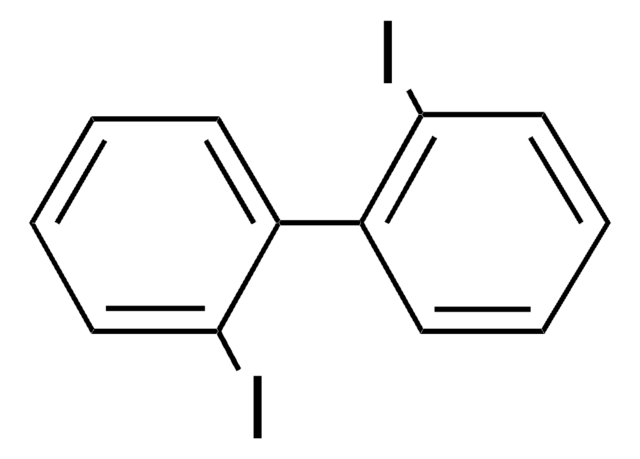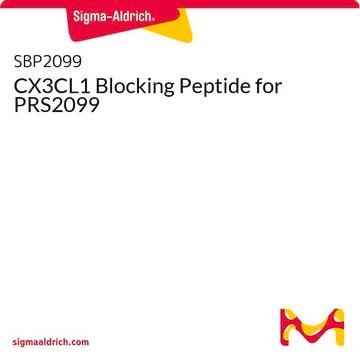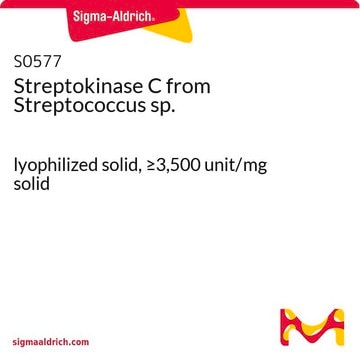Upon verification, the laboratory has not characterized the biological activity of SAE0089. However, it is known to be reversibly inactivated by oxidation, where the active form is present in a reduced format. Therefore, just prior to application, one could activate it by incubation with DTT for about 15 minutes at 37 degrees Celsius.
SAE0089
Streptolysin O from Streptococcus pyogenes
≥1,000,000 units/mg protein, recombinant, lyophilized powder, expressed in E. coli
Sinonimo/i:
Streptolysin O from Streptococcus pyogenes, SLO
Scegli un formato
About This Item
Prodotti consigliati
Saggio
≥95% (SDS-PAGE)
Attività specifica
≥1,000,000 units/mg protein
PM
60 kDa
N° accesso UniProt
Condizioni di spedizione
ambient
Temperatura di conservazione
2-8°C
Cerchi prodotti simili? Visita Guida al confronto tra prodotti
Descrizione generale
SLO may be used for cell permeabilization or hemolysis. The susceptibility of hemolysis by SLO varies significantly for erythrocytes from different animal species.[1] Permeabilization of cells using SLO has been performed on multiple cell types and for various applications. For instance it has been used to introduce antisense oligonucleotides into cultured eukaryotic cells;[3] to investigate the effect of guanine nucleotide analogues on phosphatidylinositol metabolism and protein kinase C (PKC) activation in live human T lymphocytes;[4] to monitor cholesterol oxidation within a membrane lipid bilayer; [5] and to label proteins inside living cells using external fluorophores.[6]
Applicazioni
Azioni biochim/fisiol
Definizione di unità
Avvertenze
Danger
Indicazioni di pericolo
Consigli di prudenza
Classi di pericolo
Acute Tox. 2 Dermal - Acute Tox. 2 Inhalation - Acute Tox. 2 Oral
Codice della classe di stoccaggio
6.1A - Combustible acute toxic Cat. 1 and 2 / very toxic hazardous materials
Classe di pericolosità dell'acqua (WGK)
WGK 3
Punto d’infiammabilità (°F)
Not applicable
Punto d’infiammabilità (°C)
Not applicable
Scegli una delle versioni più recenti:
Certificati d'analisi (COA)
Non trovi la versione di tuo interesse?
Se hai bisogno di una versione specifica, puoi cercare il certificato tramite il numero di lotto.
Possiedi già questo prodotto?
I documenti relativi ai prodotti acquistati recentemente sono disponibili nell’Archivio dei documenti.
I clienti hanno visto anche
-
I purchased SAE0089 (streptolysin o). I see in many protocols and one of your datasheets that Streptolysin o should be treated with 10 mM dithiothreitol before using it. However, I don't see that indication anywhere for SAE0089. Do I still need to treat it with DTT?
1 answer-
Helpful?
-
Active Filters
Il team dei nostri ricercatori vanta grande esperienza in tutte le aree della ricerca quali Life Science, scienza dei materiali, sintesi chimica, cromatografia, discipline analitiche, ecc..
Contatta l'Assistenza Tecnica.
